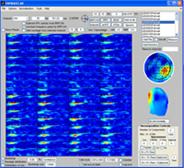|
The Current measure used |
|
In this area the measure to investigate is selected. A mathematical explanation of each of the measures is given in the ERPWAVELAB article. Note, to calculate linear coherence rather than phase coherence, check the Linear Coherence menu point in Options -> Linear Coherence. ERPCOH: Event Related Phase Coherence (measures how well the activity between regions are phase locked over epochs) ITPC: Inter Trial Phase Coherence (also named the phase locking index, measures how well a given activity is phase coherent to the event) ERSP: Event Related Spectral Power (Measures the average power over epochs) WTav: Gives the average amplitude of each time-frequency point over the epochs. avWT: Gives the amplitude of the Evoked Potential (EP) Induced: WTav-avWT, i.e. the activity that is not evoked. Test of dif: Analysis of difference between groups of measurements. Provided are ANOVA and Kruskal-Wallis test of difference. While ANOVA is recommended if data can be assumed normal distributed Kruskal-Wallis is useful when this assumption does not hold. The confidence level is given by the significance level selected. Once the button is pressed a new window opens enabling you to define what datasets belong to which group as well as what type of test of difference to perform. The calculated test values are displayed in the montage plot. Epochs: When this button is pressed the user interface changes to epoch rejection mode.
|

|
Developed by Morten Mørup |
|
A tOOLbox FOR MULTI-CHANNEL TIME-FREQUENCY ANALYSIS |



